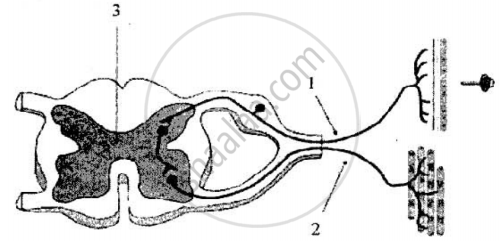Advertisements
Advertisements
Question
The part of brain which controls the involuntary action such as heart beat, breathing, blood pressure, etc. is :
(a) pons
(b) medulla
(c) cerebrum
(d) cerebellum
Solution
(b) medulla
The medulla controls various involuntary actions such as the heart beat, breathing, blood pressure and the peristaltic movement in the body.
APPEARS IN
RELATED QUESTIONS
With the help of a neat and labelled diagram, describe reflex arc.
Name one gustatory receptor and one olfactory receptor present in human beings.
The diagram given below shows the internal structure of a spinal cord depicting a phenomenon. Study the diagram and answer the questions:

1) Name the phenomenon that is depicted in the diagram. Define the phenomenon.
2) Give the technical term for the point of contact between the two nerve cells.
3) Name the parts numbered 1, 2 and 3.
4) How does the arrangement of neurons in the spinal cord differ from that of the brain?
5) Mention two ways by which the spinal cord is protected in our body.
Write the names of the regions in hindbrain. Give one function of each region.
What is the difference between a voluntary and an involuntary action? Which kind of action is digestion? Explain your choice.
Which of the following cannot be considered a receptor?
(a) ear
(b) nose
(c) muscle
(d) eye
Note the relationship between the first two words and suggest the suitable word/words for the fourth place.
Receptor : Sensory nerve :: Motor nerve : ______.
What will you do if someone pricks your hand with a needle? Elucidate the pathway of response with a neat labelled diagram.
Which sensory organ is involved in vertigo (sensation of oneself or objects spinning around)?
How is the mode of action in beating of the heart different from reflex actions? Give four examples.
